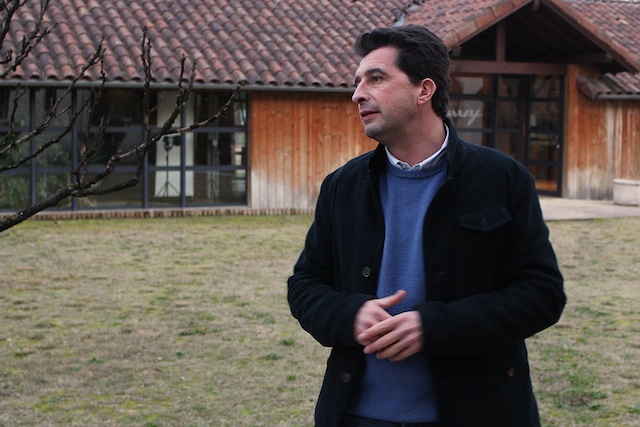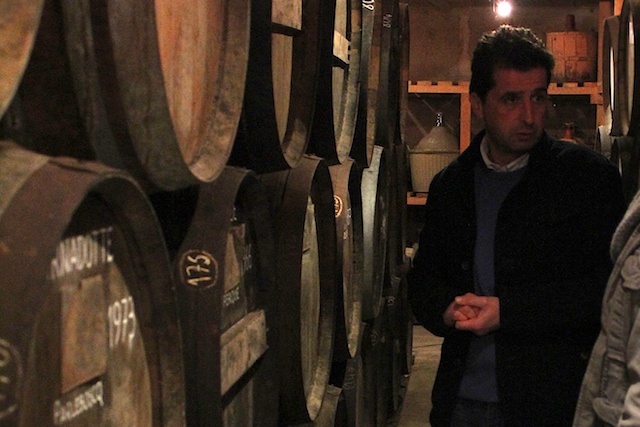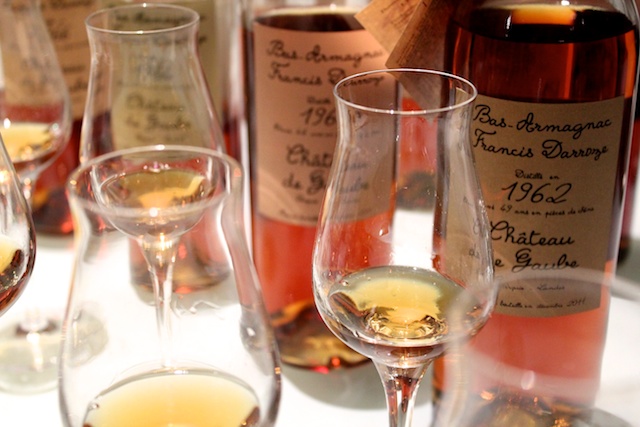An Interview with Marc Darroze
 Marc Darroze in front of the Darroze office in 2012
Marc Darroze in front of the Darroze office in 2012
Now that Darroze Armagnac is once again being imported into the United States and is available at K&L, I thought it might be the right time to shed a little more light onto who exactly Marc Darroze is and what he does as an independent bottler of brandy. We visited Darroze in 2012, after Marc had decided not to continue on with Preiss as his importer. We were hoping to find a few things to bring in via Charles Neal, therefore all of the photos you'll see here are from that appointment. My notes, however, are a bit hazy and hard to read at this point, so I decided to call Marc this morning and make sure all of my information was correct. The following interview is based on that conversation:
David: Now that you're working with Vintage 59, how are you determining which selections to bring to the states? Are they tasting and deciding, or are the selections based on your decisions?
Marc: We make a decision together to have at least a few different vintages from each producer and to have the blends as well. However, once a year we also arrange for pre-orders to be done with larger accounts like K&L where we propose to clients the opportunity to make their own selections. This most recent selection, however, was made by me based off of what I like, different styles, and the volume from what I have in stock here in France.
David: I think the selection has been great so far. When it comes to the Assemblages, who is blending those? Are you doing it, or are you hiring a master blender of sorts?
Marc: No, I do it myself. In fact, I started work on these blends two years ago, working for at least sixteen months on perfecting them. The goal was to create a complete range of blended Armagnac from eight to sixty years old. Of course, the idea was not to add any caramel, or tannins, or sugar and to showcase the age of the Armagnac at the time. For example the eight year old will be light in color and very fruity. The older the Armagnac, the more we'll find the influence of the maturation. The eight, twelve, and twenty have been diluted slightly with water, but the others are naturally at 42 or 43% alcohol.
David: And how many different Armagnacs are in each one? How many different estates are used in each blend?
Marc: First off, we're not using the estates from the Darroze estate collection to make the blends – it's really a special selection of different brandies. Last year, in 2012, I had already started to distill some wine especially for the future selections, so they'll be their own thing. To give you an idea, there are eight different Armagnacs in the eight year, nine different Armagnacs in the twelve, and in the twenty year old there are six. So depending on each blend, what I want to do is be consistent in each style. I choose the style based on what I will be able to recreate in the future. It's very different than the estate selections where we respect the vintage and character of each different producer. With the blends we are looking at the potential for each Armagnac to work well with another. That was a new job for me, honestly, we never did this in the past. It was a long job. It took eight months just to find the style, but now after two years we've made two or three different versions of the twelve year, all just as fruity as the previous ones.
 In the cellars at Darroze, 2012David: So none of the brandy in the Assemblages selections comes from any estate bottled individually by Darroze?
In the cellars at Darroze, 2012David: So none of the brandy in the Assemblages selections comes from any estate bottled individually by Darroze?
Marc: Correct. In the twenty year we actually use twenty, twenty-two, and twenty-six year old brandy in the blend, but of course labeling law requires we list the youngest in the blend.
David: Of the estates that are bottled by Darroze, is it true that most of them do not sell Armagnac under their own label, but are actually only available from you?
Marc: Yes, correct.
David: They are exclusive to you?
Marc: Exactly.
David: How long have these relationships been in place? Back generations?
Marc: No, not really. I am the third generation, but the history of my company is that we were a restaurant family. My father and grandfather worked together in a restaurant in Gascony. In the 50s and 60s it was possible for restaurants to go directly to the farm – to buy some chickens, eggs, vegetables, foie gras – and in Armagnac, normally at this time, the producer of Armagnac did not only produce brandy. They grew corn, raised chickens, so when my father and grandfather went to these farms they had the opportunity to taste older Armagnacs maturing there, waiting for....I don't know what exactly. But you know it used to be that the people on the farms would keep their Armagnac for the bad days when they had to change the roof or replace the tractor and they could sell off a barrel to make some money. My father and grandfather used to select some Armagnac by the bottle to sell by the glass at the restaurant. At the end of the 60s my father decided to propose to these producers to buy complete casks and to bottle them himself with the name of the estate and the vintage on the label. So these relationships really began at the end of the 60s. Year after year, he increased the amount of selections and vintages. I came on about sixteen years ago to help develop more relationships. Every year we have our partnership were we distill the wine. We have an alembic still that we bring from estate to estate to distill and we then take the spirit and mature it in our own cellar.
David: So you're in control of the brandy from the wine on?
Marc: Yes, exactly. But for the old Armagnacs, of course, some of them began maturing in their own cellar and we finished aging them in ours. Eighty percent of the volume in our cellar is younger Armagnac and the other twenty is mature from the producer. If we have the opportunity to buy older stocks, and if they're up to the quality with no caramel added, of course we will buy them and finish the maturation in our cellar.
 Tasting the various estates, 2012David: Let's look at some of these estates. In the case of Domaine de Bordevielle, what can you tell us?
Tasting the various estates, 2012David: Let's look at some of these estates. In the case of Domaine de Bordevielle, what can you tell us?
Marc: You have the 1975, which is all Baco. This is a small estate, like three and a half hectares, only planted with Baco in the sandy soils, which are the best for producing more complex Armagnac. It's matured in locally-produced oak barrels. The grains of this oak are larger than usual, which allows for a bit of a faster oxidation process. It's important because we don't dilute, so the accelerated oxidation helps. The older Baco makes a very unique style. Powerful, but smooth, because Baco after twenty-five or thirty years is very smooth. Very finessed.
David: How about Domaine Bernadotte?
Marc: Made with Baco. This Armagnac has been matured in quite unique conditions because their cellar was quite humid. The more humid the cellar, the more alcohol we lose, so we get a very round and soft brandy. We've had it maturing in our cellar for about ten to twelve years now.
David: What can you tell me about Domaine de Busquet?
Marc: Busquet is also an estate where the maturation began in their own cellar. They have used some new casks for six or seven years before moving it into older barrels. Normally the brandy coming from them is darker due to the long contact with new oak. It's also made with Baco, so this Armagnac works very well with chocolate or cigars because of its dark and tannic character. Very smooth as well.
David: And lastly Domaine Pounon.
Marc: This one is still very young and fruity. 1993 is about twenty years in the cask, it's made with Baco and a little Ugni Blanc. An interesting Armagnac for introducing people to vintage, undilluted Armagnac. It's an easier style, lighter in color. Less new oak than Busquet. Very well balanced and fruity.
David: What is your favorite of the estates that you bottle?
Marc: I like Chateau du Gaube a lot because this Armagnac was matured in very large oak barrels and because of the volume there was a very interesting oxidation. All of these Armagnacs are very expressive, very intenses, and soft in tannins. They're all very different in style, but there is a consistent character, so that you can tell they were all made at the same place. I also like younger Armagnacs made with Folle Blanche, they are very elegant in style.
I also like the Armagnac from Domaine au Martin. It's an estate we distill at every year and they use all four Armagnac varietals: Folle Blanche, Baco, Ugni Blanc, and a little bit of Colombard. Colombard is not my favorite grape, but in the blend it is interesting. Because we have a partnership with this estate, we control the maturation from beginning to end.
David: When a producer uses four different varietals like that, do they vinify and distill them separately, or are they blending them together before distillation?
Marc: We prefer to distill each grape separately. If you look at Folle Blanche, it creates a very fine Armagnac so we don't use too much new oak when maturing it because it will hide the character of the grape – a maximum of eighteen months. Whereas Baco for example is a grape than can support much more oak contact, so we usually keep it in new oak for five to six years. After that we transfer it to an older cask. We always start with new oak, but for different amounts of time depending on the varietal.
David: So if there are four different distillates from each estate, but it's bottled as a vintage, do you then blend them to create the vintage expression?
Marc: Exactly. But we only bottle to order, so we will blend them and put them back into the barrel to await that request. After eight, nine, ten years we blend them together and they'll continue to age after that in cask. We don't have any stock in bottle.
-David Driscoll
